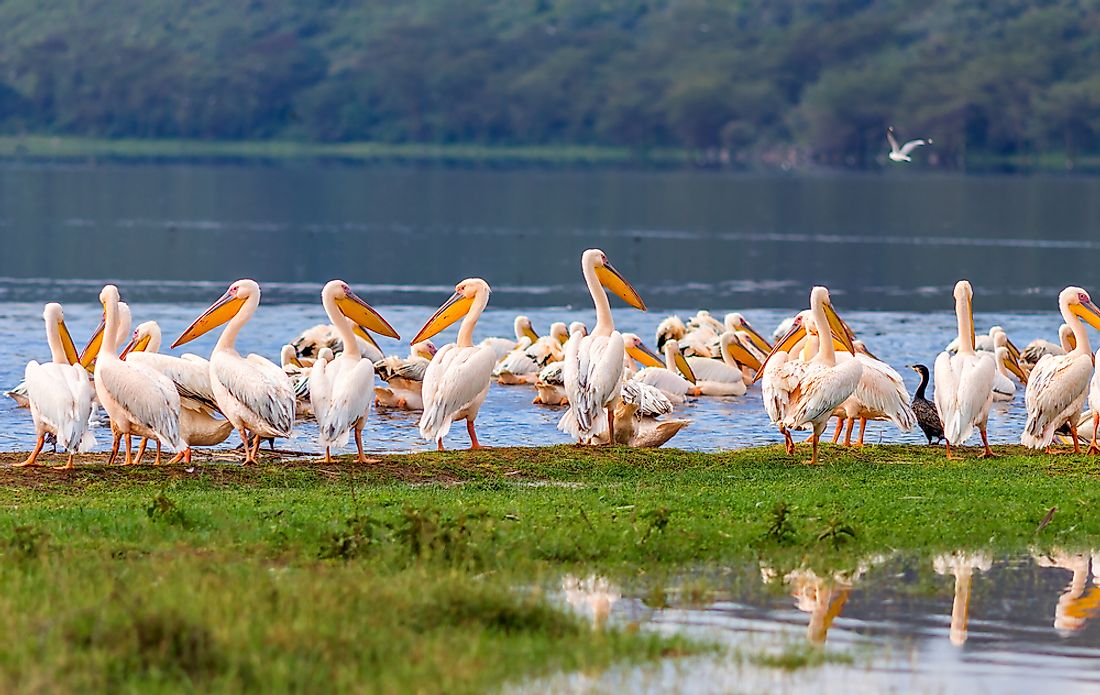The Rift Valley Lakes of Kenya

The East African Rift Valley hosts some of the world’s largest and deepest lakes. The Kenyan section of this rift valley is home to eight lakes including three freshwater and five saline lakes. Some of these lakes are quite shallow with salt deposits on the shores that support crustacean populations. Large flocks of flamingo feed on these crustaceans. These lakes also support other types of fauna and are also important to the Kenyan economy. The eight lakes of the Kenyan section of the East African Rift Valley have been mentioned below.
8. Lake Baringo
Lake Baringo is the second most northern of the Kenyan Rift Valley lakes. It covers an area of 130 square km at an elevation of 1,000 m. Lake Baringo is fed by several rivers but has no significant outlet. It is, however, a freshwater lake. The waters of this lake are believed to seep into the faulted volcanic bedrock below. Lake Baringo provides important habitat to over 500 species of birds like flamingos, herons, migratory waterbirds, etc. Several species of freshwater fish like the Nile tilapia are found in its waters. Hippopotamus and Nile crocodiles also live in the lake. Several small islands and volcanic features are found in and around the lake respectively.
7. Lake Bogoria
Lake Bogoria, a saline, alkaline lake, and a Ramsar Wetland, is located south of Lake Baringo close to the equator in Kenya. The lake and its environs are protected as the Lake Bogoria National Reserve as it hosts one of the world’s largest populations of lesser flamingos. The lake is about 3.5 km wide and 34 km long. It is relatively shallow with a depth of about 10 m and is located at an elevation of 990 m. Geysers and hot springs are present along the bank of the lake. Despite its hypersalinity, Lake Bogoria supports abundant cyanobacteria that attract flamingos in large numbers to this lake.
6. Lake Elmenteita
Also a Ramsar Wetland, Lake Elmenteita is a soda lake located about 120 northwest of Nairobi. It is located at an elevation of 1670 m and occupies an area of 18 square km. It is quite shallow (less than 1 m deep). The spectacular vista of the lake can be enjoyed by motorists on the Nairobi-Nakuru highway which runs near the lake. Over 400 bird species including flamingos, pelicans, night herons, etc., are found in the lake area in large numbers. A species of fish called the Tilapia grahami breeds in the "Kekopey" hot springs at Lake Elmenteita southern end. Wild animals like eland, gazelle, and zebras graze on the shores of the lake.
5. Lake Logipi
The saline, alkaline Lake Logipi is located in the Suguta Valley’s northern end in the northern part of the Kenya Rift. This lake has a maximum length and width of 6 km and 3 km respectively. It is 3 to 5 m deep. Saline, hot springs supply waters to the lake. The Suguta River also adds water to the lake during the rainy season. Flamingos visit Lake Logipi in large numbers to feed on the cyanobacteria in the lake.
4. Lake Magadi
The southernmost lake in the Rift Valley of Kenya, Lake Magadi covers an area of 100 square km. It is located north of Lake Natron of Tanzania. Like most other lakes in the region, Lake Magadi is also a saline and alkaline lake with an endorheic basin. Saline hot springs drain into the lake. Although the lake serves as the feeding ground of several species of wading birds, little life is found in its hot, highly alkaline waters. A cichlid species Alcolapia grahami is the only lifeform found in its waters.
3. Lake Naivasha
Lake Naivasha is one of the two freshwater Kenyan Rift Valley lakes, the other being Lake Baringo as mentioned earlier. Lake Naivasha is found in Nakuru County just outside the Naivasha town. The lake occupies an area of 139 square km. It is located at an elevation of 1,884 m, the highest elevation of the Kenyan Rift valley, and has a maximum depth of 30 m. The lake is supplied by the Malewa and Gilgil rivers and other streams. Although the lake has no visible outlet, it is believed that its drains through subterranean crevices on the lake bed. Lake Naivasha also has rich biodiversity including more 400 bird species and a large hippo population. Floriculture and fishing are the two major sources of income for people living around this lake.
2. Lake Nakuru
Lake Nakuru is located in the Lake Nakuru National Park at an elevation of 1,754 m above sea level. The lake’s surface area varies considerably from 5 to 45 square km both seasonally and by year. It has an average depth of only 0.30 m and a maximum depth of 1.8 m. Protected within the limits of a national park, Lake Nakuru and its surroundings support a variety of fauna like eastern black rhinos, southern white rhinos, baboons, warthogs, flamingos, and more.
1. Lake Turkana
A UNESCO World Heritage Site, Lake Turkana is located in northern Kenya at the Kenya-Ethiopia border. A small part of the lake extends beyond Kenya’s borders into Ethiopia. Lake Turkana is the largest alkaline lake in the world. It is also the world’s largest permanent desert lake. The lake supports rich lacustrine wildlife but is currently threatened by the Gilgel Gibe III Da in Ethiopia. The dam proposed to be constructed on the Omo River will deprive the lake of most of its water. Lake Turkana is 290 km long and has a maximum width of 32 km. It is 30.2 m deep at its deepest point and is located at an elevation of 360.4 m.











